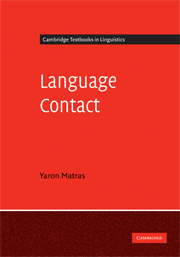Book contents
- Frontmatter
- Contents
- List of figures
- Preface
- List of abbreviations
- 1 Introduction
- 2 An emerging multilingual repertoire
- 3 Societal multilingualism
- 4 Acquiring and maintaining a bilingual repertoire
- 5 Crossing the boundaries: codeswitching in conversation
- 6 The replication of linguistic ‘matter’
- 7 Lexical borrowing
- 8 Grammatical and phonological borrowing
- 9 Converging structures: pattern replication
- 10 Contact languages
- 11 Outlook
- Notes
- References
- Author index
- Language index
- Subject index
2 - An emerging multilingual repertoire
Published online by Cambridge University Press: 05 June 2012
- Frontmatter
- Contents
- List of figures
- Preface
- List of abbreviations
- 1 Introduction
- 2 An emerging multilingual repertoire
- 3 Societal multilingualism
- 4 Acquiring and maintaining a bilingual repertoire
- 5 Crossing the boundaries: codeswitching in conversation
- 6 The replication of linguistic ‘matter’
- 7 Lexical borrowing
- 8 Grammatical and phonological borrowing
- 9 Converging structures: pattern replication
- 10 Contact languages
- 11 Outlook
- Notes
- References
- Author index
- Language index
- Subject index
Summary
A case study
The present chapter examines the emergence of the linguistic repertoire in an individual speaker in a multilingual setting. It traces the gradual development of constraints on the selection of structures within the repertoire and the acquisition of strategies to manage that repertoire. These strategies constitute the foundations on which bilinguals draw when alternating between languages. They also form the background and the pre-requisite for any contact-induced change. By surveying the bilingual child's strategies of managing the linguistic repertoire, we obtain a picture of the potential effects of language contact on speakers, on language use, and on the shape and structure of language.
I base this chapter on informal observations of the language acquisition process of a trilingual child, whom we shall call ‘Ben’. Born and raised in England in the late 1990s, Ben is exposed to two languages in the home: German, which he hears from his mother, and Hebrew, which he hears from his father. Both parents speak their respective languages consistently to Ben, consciously trying to avoid mixing. Between the ages of 0:4 and 4:4, input is balanced: During the first two years of his life Ben spends four days a week with an English-speaking child minder. He is cared for at home during roughly half of the working week primarily by his father, and during the other half primarily by his mother, while weekends are spent with both parents. At the age of 1:11, Ben's parents move into separate households, in separate towns.
- Type
- Chapter
- Information
- Language Contact , pp. 9 - 40Publisher: Cambridge University PressPrint publication year: 2009

